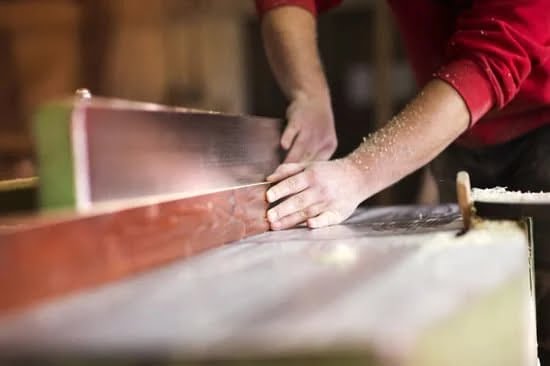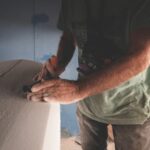Woodworking is a rewarding and fulfilling hobby or profession, but it also comes with its fair share of safety risks. One of the most important safety measures that woodworkers should prioritize is wearing safety glasses. Whether you are a beginner or a seasoned professional, protecting your eyes should always be a top priority when working with wood.
In this article, we will explore the different types of safety glasses for woodworking, the key features to look for in safety glasses, the potential dangers of not wearing them, how to choose the right pair for your projects, and tips for proper maintenance and care. Making the right choices when it comes to safety glasses can make all the difference in preventing serious injuries.
Safety glasses are an essential piece of personal protective equipment (PPE) for anyone working with wood due to the potential hazards in the workshop. Woodworking exposes your eyes to various dangers such as flying debris, sawdust, sharp objects, and even chemicals from wood treatments. Therefore, selecting the right type of safety glasses is crucial to ensure optimal eye protection without compromising comfort or visibility.
In this comprehensive guide on safety glasses for woodworking, we will discuss the types of safety glasses available including clear lens, tinted lens, and anti-fog options. We will also delve into important features to consider when choosing safety glasses such as impact resistance and UV protection. Additionally, we will highlight the potential dangers of not wearing safety glasses in woodworking and provide valuable tips for selecting the most suitable pair for your specific woodworking projects.
Types of Safety Glasses for Woodworking
When it comes to woodworking, safety should always be a top priority. One of the most important safety measures to take when working with wood is wearing the appropriate safety glasses. There are various types of safety glasses available for woodworking, each offering different features and benefits. It’s important to understand the options available so you can choose the right one for your needs.
1. Clear Lens: Clear lens safety glasses are a popular choice for woodworking as they provide a clear field of vision without distorting colors. They are ideal for indoor woodworking projects where adequate lighting is present.
2. Tinted Lens: Tinted lens safety glasses are great for outdoor woodworking projects or when working with bright lights. They help reduce glare and provide protection from harmful UV rays.
3. Anti-Fog: When working in humid conditions or during strenuous tasks, anti-fog safety glasses are essential to maintain clear visibility and prevent fogging up.
4. Polarized Lens: Polarized safety glasses are effective at reducing glare and enhancing contrast, making them suitable for woodworking tasks that involve high-contrast environments.
5. Prescription Safety Glasses: For those who need prescription glasses, there are specialized options available that provide both vision correction and eye protection.
It’s important to consider your specific needs and work environment when choosing the right type of safety glasses for woodworking projects. Whether you prefer clear lens for indoor use or tinted lens for outdoor projects, prioritizing eye protection with the right safety glasses is crucial in ensuring a safe and enjoyable woodworking experience. Remember that a small investment in quality safety glasses now can prevent costly eye injuries in the future.
Remember to always wear your safety glasses for woodworking.
Features to Look for in Safety Glasses
When it comes to woodworking, safety should always be a top priority. One of the most essential pieces of safety equipment for woodworkers is a pair of safety glasses. But not all safety glasses are created equal. When choosing the right pair of safety glasses for woodworking, there are several key features to look for to ensure maximum protection and comfort.
Impact Resistance
One of the most important features to look for in safety glasses for woodworking is impact resistance. Woodworking often involves tools and machinery that can produce flying debris and particles, posing a risk to the eyes. Look for safety glasses with lenses that are certified to meet impact resistance standards to protect against potential hazards in the workshop.
UV Protection
Many woodworkers spend extended periods of time working outdoors or near windows, where they may be exposed to harmful UV rays. It’s important to choose safety glasses with UV protection to shield the eyes from both UVA and UVB rays, reducing the risk of long-term damage such as cataracts or other eye conditions.
Comfortable Fit
Comfort is another crucial factor when selecting safety glasses for woodworking. Uncomfortable or ill-fitting glasses can become a distraction and may lead to decreased productivity and compromised safety. Look for options with adjustable temples and nose pads, as well as lightweight frames that won’t cause discomfort during extended wear.
By prioritizing features such as impact resistance, UV protection, and comfortable fit when choosing safety glasses for woodworking, woodworkers can significantly reduce their risk of eye injuries and ensure a safer work environment.
Dangers of Not Wearing Safety Glasses in Woodworking
Woodworking can be a rewarding and enjoyable hobby, but it also comes with its own set of risks, especially when it comes to eye safety. The dangers of not wearing safety glasses in woodworking cannot be overstated, as the eyes are extremely vulnerable to injury from flying debris, sawdust, and splinters. Without proper eye protection, woodworkers are at risk of sustaining serious and potentially irreversible eye injuries.
The following are some of the potential dangers of not wearing safety glasses while woodworking:
- Eye Injuries: Flying wood chips, small particles, or even larger pieces of wood can easily cause eye injuries such as scratches, cuts, or punctures.
- Splinters: When working with wood, there is always a risk of getting splinters in the eyes if they are not adequately protected.
- Sawdust: Sawdust produced during woodworking projects can irritate the eyes and cause discomfort or more serious issues if not kept out with proper eye protection.
It is essential for woodworkers to understand the potential hazards they face when not using safety glasses. While these risks may seem insignificant at times, the consequences of an eye injury can be severe. A proactive approach to wearing safety glasses for woodworking is crucial for maintaining eye health and preventing accidents that could lead to permanent damage.
Remember that prioritizing eye protection by wearing safety glasses for woodworking is a simple yet effective way to avoid potential dangers in the workshop. Staying mindful of these risks and taking proactive measures to mitigate them ensures a safe and fulfilling woodworking experience.
Choosing the Right Safety Glasses for Your Woodworking Projects
When it comes to woodworking, choosing the right safety glasses is crucial for protecting your eyes from potential hazards. Whether you are a beginner or an experienced woodworker, it is important to prioritize eye protection in your projects. Selecting the right safety glasses involves considering factors such as fit, style, and durability.
Fit
Finding safety glasses that provide a comfortable and secure fit is essential for ensuring maximum protection. Ill-fitting glasses can easily slip off or become uncomfortable during long hours of woodworking. Look for safety glasses with adjustable temples and nose pads to customize the fit to your face shape.
Style
While the primary purpose of safety glasses is protection, it doesn’t mean you have to compromise on style. There are various styles of safety glasses available, including wraparound, semi-rimless, and full-frame designs. Choose a style that suits your personal preference while providing adequate coverage and protection for your eyes.
Durability
Woodworking can be a rugged activity that exposes safety glasses to wear and tear. Opt for safety glasses made from durable materials such as polycarbonate lenses and sturdy frames. Additionally, look for scratch-resistant coatings to prolong the longevity of your safety glasses.
By considering factors such as fit, style, and durability when choosing safety glasses for woodworking projects,you can ensure that your eyes are properly protected without sacrificing comfort or aesthetics in the workshop.
Tips for Proper Maintenance and Care of Safety Glasses
Proper maintenance of safety glasses is crucial in ensuring their effectiveness in protecting your eyes during woodworking projects. Regular cleaning, proper storage, and timely replacement are all important aspects of maintaining the integrity of your safety glasses.
When it comes to cleaning your safety glasses for woodworking, it’s essential to use the right products and techniques to avoid damaging the lenses or frames. Use a mild soap or specialized lens cleaner and a soft, clean cloth to gently wipe away any dirt, sawdust, or debris. Avoid using rough materials or abrasive cleaners that could scratch or otherwise compromise the integrity of the glasses.
Proper storage of your safety glasses is also important in preventing damage. When not in use, store them in a protective case or pouch to shield them from dust and potential impacts. Avoid placing them face down on surfaces where they can get scratched, and never leave them in direct sunlight where excessive heat could cause damage.
Lastly, regular replacement of safety glasses is crucial for maintaining their effectiveness. Over time, wear and tear can compromise the structural integrity of the glasses, reducing their ability to provide adequate protection. Inspect your safety glasses regularly for signs of damage or deterioration, and replace them as needed to ensure that you always have reliable eye protection for your woodworking projects.
| Aspect | Description |
|---|---|
| Cleaning | Use mild soap or specialized lens cleaner and a soft cloth |
| Storage | Store in a protective case or pouch away from direct sunlight |
| Replacement | Regularly inspect for damage and replace as needed |
Conclusion
In conclusion, safety glasses for woodworking are a crucial piece of equipment that should never be overlooked or taken lightly. The potential dangers of not wearing proper eye protection in woodworking projects, such as splinters, sawdust, and flying debris, can lead to severe eye injuries that could have long-lasting effects. It is essential to prioritize the safety of your eyes by investing in high-quality safety glasses designed specifically for woodworking.
When selecting safety glasses for woodworking, it is important to consider features such as impact resistance, UV protection, and a comfortable fit. Whether you opt for clear lens or tinted lens safety glasses, ensuring they provide adequate protection against potential hazards is paramount.
Additionally, proper maintenance and care of your safety glasses are crucial for their effectiveness. Regular cleaning, appropriate storage, and timely replacement when necessary will help ensure that your safety glasses continue to provide the level of protection you need.
In the realm of woodworking projects, it is easy to get caught up in the intricacies of the work at hand and overlook the importance of safeguarding one’s eyes. However, by choosing the right safety glasses and making a conscious effort to wear them regularly during woodworking tasks, you can significantly reduce the risk of potential eye injuries.
Remember that protecting your vision should always be at the forefront of any project involving woodwork. Your eyesight is irreplaceable, so do not compromise on safety when it comes to woodworking activities.
Frequently Asked Questions
What Are Safety Glasses Used for in Woodworking?
Safety glasses are essential in woodworking to protect the eyes from flying wood chips, sawdust, splinters, and other debris that can cause injury. They provide a barrier against potential eye hazards, ensuring the woodworker’s safety.
Should You Wear Safety Glasses When Chopping Wood?
Yes, wearing safety glasses when chopping wood is highly recommended. The process of chopping wood creates a lot of flying debris, making it crucial to protect the eyes from any potential impact or injury. Safety glasses provide that necessary protection.
When Should Safety Glasses Be Worn in a Workshop?
Safety glasses should be worn in a workshop whenever there is a risk of eye injury from flying particles, dust, chemical splashes, or any other potential hazards. Whether using power tools, hand tools, or handling hazardous materials, wearing safety glasses is a proactive measure to prevent eye-related injuries.

Hi everyone! I’m a woodworker and blogger, and this is my woodworking blog. In my blog, I share tips and tricks for woodworkers of all skill levels, as well as project ideas that you can try yourself.





